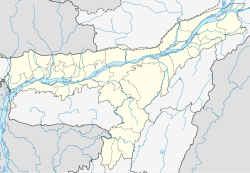This article needs additional citations for verification .(May 2025) |
Maibang | |
|---|---|
Town | |
| Coordinates: 25°17′43″N093°08′22″E / 25.29528°N 93.13944°E | |
| Country | |
| State | Assam |
| District | Dima Hasao |
| Government | |
| • Type | Maibang Town Committee |
| Area | |
• Total | 10 km2 (3.9 sq mi) |
| Elevation | 355 m (1,165 ft) |
| Population (2011) | |
• Total | 6,236 |
| • Density | 620/km2 (1,600/sq mi) |
| Languages | |
| • Most common | Bengali, Dimasa, Hindi, Assamese [1] |
| • Most spoken language | Bengali |
| Time zone | UTC+5:30 (IST) |
| PIN | 788831 |
| Telephone code | +91 |
| Vehicle registration | AS-08-X XXXX |
Maibang (IPA: mai-bang [mai means rice and bang means much], defining a land of prosperity) is a town and a town area committee in Dima Hasao district in the Indian state of Assam. Maibang is also one of the three sub-divisions of Dima Hasao District. It was once the capital of the Dimasa Kachari Kingdom. There is a stone house of Dimasa king.

